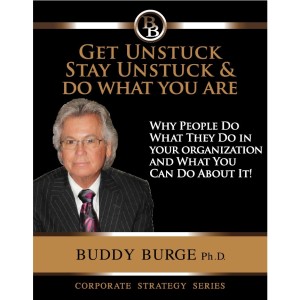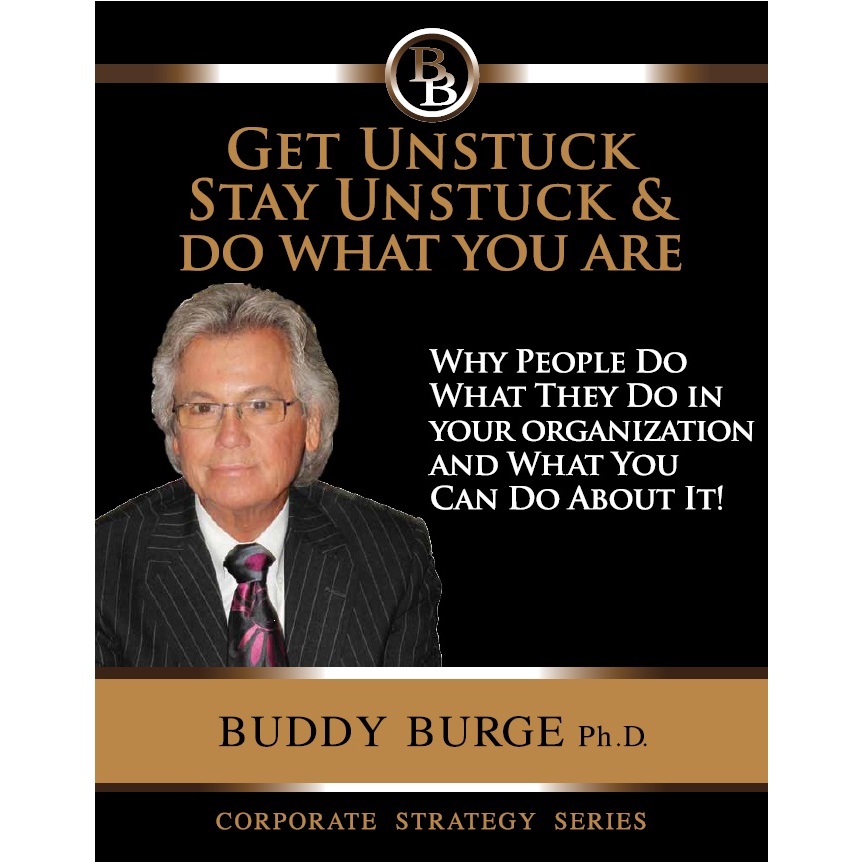The following article is from “Get Unstuck, Stay Unstuck and Do What You are“
The Three Primary Determinants to Interpersonal Interaction
In this and the several next posts, I am going speak to the “things”, I call them “Determinants” that make people do what they do.
In the “Individual Behavior Model” diagram below, notice that there are three determinants that forge and shape our experiences, and understanding of our lives but that these three determinants have a hierarchy to them.
In other words, the three determinants are the filter we use to respond to life.
You could say that our filter is us.
Individual Behaviour Model: Three Determinants Make People Do What They Do
![CropperCapture[524]](http://buddyburge.com/wp-content/uploads/2013/08/CropperCapture524.png)
1. System: Determines how everybody tends to act and react all the time
Everybody stops at a red light and so forth.
2. Situation: Determines how most people tend to act and react most of the time
People will generally fit in with the social or team situations and so forth
3. Self: Our Temperament – Determines how each individual tends to act and react all the time
Individual people have unique biological preferences; a default position.
All things being considered, this is how they would like their life to be.
“Individual” Behavior Model
![CropperCapture[517]](http://buddyburge.com/wp-content/uploads/2013/08/CropperCapture517-300x281.png)
Individual Behavior Model: Who am I, What Makes Me Do What I Do & What can I Do about It?
You might recall in section one that we spoke about the three team sports Baseball, Football and Basketball that reflect and reveal in concrete terms the three systems that companies use to effectively run their operations.
But just as there is an organizational model to understand and manage the three primary determinants in your company, there is also an individual model to understand and manage the three primary determinants in people, including you and me.
The truth is that there are three of us (three different determinants) operative in our personality at any given moment. The part of our personality that shows itself depends on which social circumstance in which we find ourselves.
Remember Corollary Twenty One from the Law of Reciprocity.
I am always like this (this is what I am like); except when I’m not and except when I cannot be. (Self, Situation, System)
Three Determinant Model: an Explication – Who am I and Why do I do what I Do?
![CropperCapture[518]](http://buddyburge.com/wp-content/uploads/2013/08/CropperCapture518-300x228.png) In order to know how to lead people effectively, we must first understand what makes people do what they do so that we can respond in the moment to the task at hand.
In order to know how to lead people effectively, we must first understand what makes people do what they do so that we can respond in the moment to the task at hand.
Remember, the goal here is not to get the right strategy, but to get the strategy right.
That means I need to have in my repertoire the capacity to be nimble and respond in the moment to the reaction of the target person and to the leadership task at hand.
What follows in this chapter is an interpretation of how the human personality is affected by and at the same affects people’s behaviors in the work place.
Our hypothesis will be that there are three of us operative in our personality at any given point in time.
The part of our personality that shows itself depends on the social circumstance in which we find ourselves given the task at hand.
As the diagram above suggests, you could say there are three of us:
- The “Me” that is my “System”
- The “Me” that is my “Situation”
- The “Me” that is my “Self”
We will discuss the three determinants starting with System, the most powerful (organizationally), concluding with the least powerful but the most visceral (personally, the Self.
The Three Determinant Model
Three Observations
![CropperCapture[519]](http://buddyburge.com/wp-content/uploads/2013/08/CropperCapture519.png)
The Three Circles: Three Observations
Observation One: The Three Circles are not all the Same Size
Observation Two: The Circles Overlap
Observation Three: The Circles Move In a Specified Direction (Downward)
Observation One: The Three Circles are not all the Same Size
![CropperCapture[520]](http://buddyburge.com/wp-content/uploads/2013/08/CropperCapture520.png)
The circles indicating the three forces or factors that determine (determinants) our interaction and behaviour in an organization are not all drawn the same size.
The arrows descend from the largest circle to the smallest to represent the sequence and manner with which the three determinants most impact people’s actions, reactions and interactions within your organization.
The “System” circle comes first and is the largest, most important and most powerful of the three determinants because of its intrinsic power over people, everybody in the organization quite literally, “all the time”.
The “Situation” circle is smaller than the system circle and comes after the system circle because it is the second most dominant factor in determining people’s behaviour, most of the time.
The “Self” circle is the smallest of the three and comes last because it is the least powerful determinant.
In spite of the fact that it is the most visceral, it is always with us, lurking in the shadows so to speak, we will nonetheless generally yield to the other two determinants.
The System Tells You What You Can and Cannot Do
![CropperCapture[521]](http://buddyburge.com/wp-content/uploads/2013/08/CropperCapture521-300x207.png)
Because we live inside the system, we often do not see its cause of or effect upon our behaviour
The System nonetheless tells you what you “can and cannot do.”
And the Situation tells you what you “should and shouldn’t do.”
While our temperament, the Self tells you what you “want and don’t want to do.”
It is however the least dominant of the three determinants.
In other words, it is important and ever present but less powerful than the first two circles.
That is why it is the last and smallest circle.
Observation Two: The Circles Overlap
![CropperCapture[522]](http://buddyburge.com/wp-content/uploads/2013/08/CropperCapture522-300x269.png)
Note that the three circles in the diagram are not isolated from each other: they overlap.
They are drawn that way to indicate that the three determinants are interrelated.
They are separate yet at the same have a profound effect upon each other.
The three are sequential, systemic and confluential.
1. Sequential: the one gives rise to the next.
2. Systemic: as the four legs of a table are equally necessary and must be equally strong, if one leg is missing or weaker than the rest, the table will eventually collapse. In other words, to be an effective leader, you need to take all three determinants into account; address them sequentially and yet simultaneously.
3. Confluential: like three intertwining strands of a rope, the three work and interact simultaneously with and upon each other as one.
The three for communication purposes are really one and need to seen as such. A good manager will govern himself accordingly.
Observation Three: The Circles Move In a Specified Direction (Downward)
![CropperCapture[523]](http://buddyburge.com/wp-content/uploads/2013/08/CropperCapture523.png)
Note that the arrows point and descend from the larger circle to the smaller circle.
There is a specified direction to the three-part interactional and behavioral process.
To truly establish lasting and positive change a wise manager will need to address all three but will make his/her priority and emphasis in descending order, the “System”, the “Situation” and lastly, his/her own and each employee’s individual “Temperament”.
Even though it is the least powerful determinant (organizationally), addressing the “Temperament” circle, the way people really are and really like things to be, what is most comfortable and safe for them, is where we can make our quickest and easiest gains.
It is also the most intriguing and fun of the three circles to address.
The goal is that your colleagues and employees treat you exactly as want to be treated and vice versa.
For effective communication to be fully realized, it is helpful to know how our core personality actually affects our interactional style.
In the next post, we will discuss the three determinants starting with System, the most powerful (organizationally), concluding with the least powerful but the most visceral (personally, the Self.
For more on this topic, we recommend the following | |
 | Get Unstuck, Stay Unstuck |


